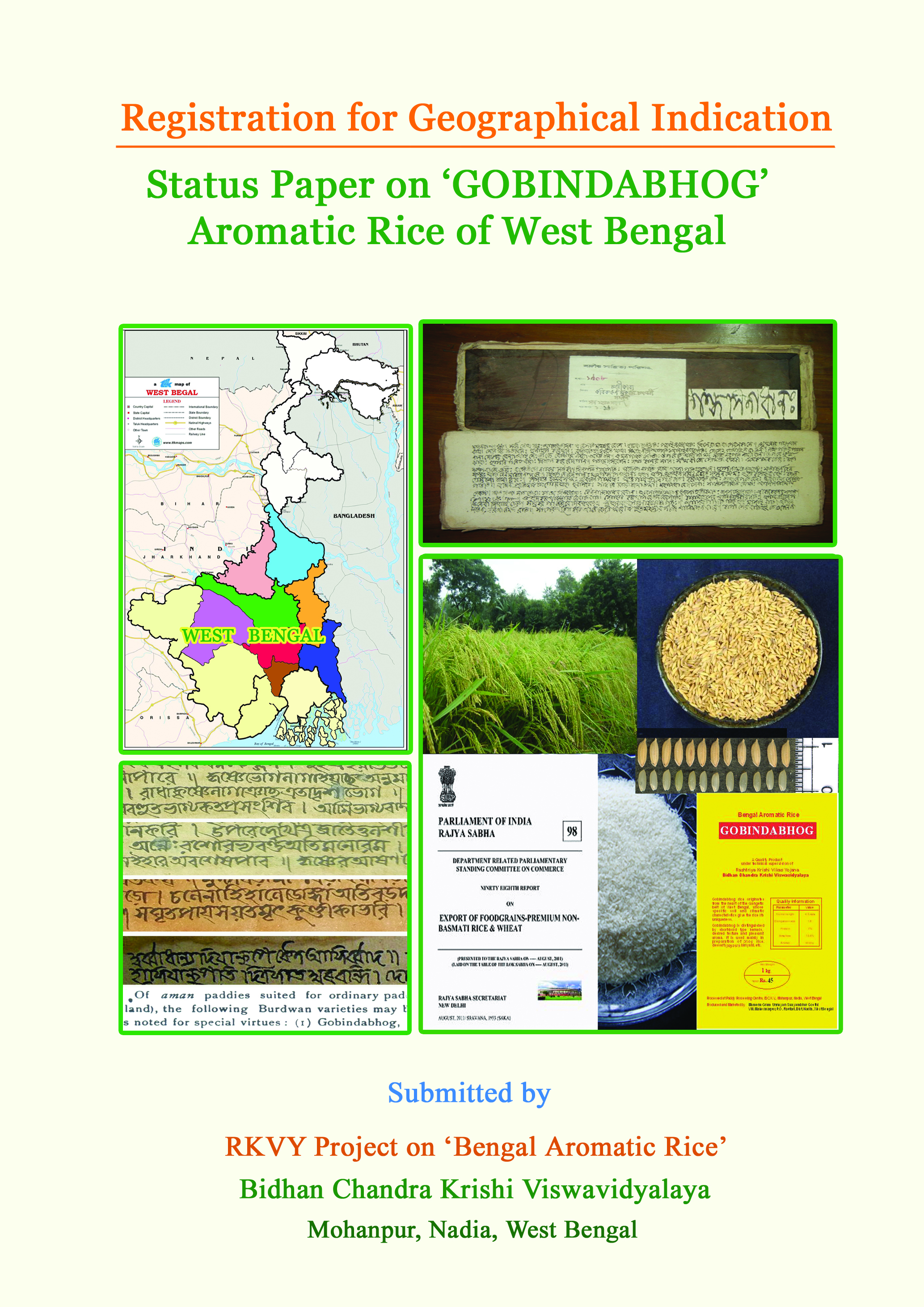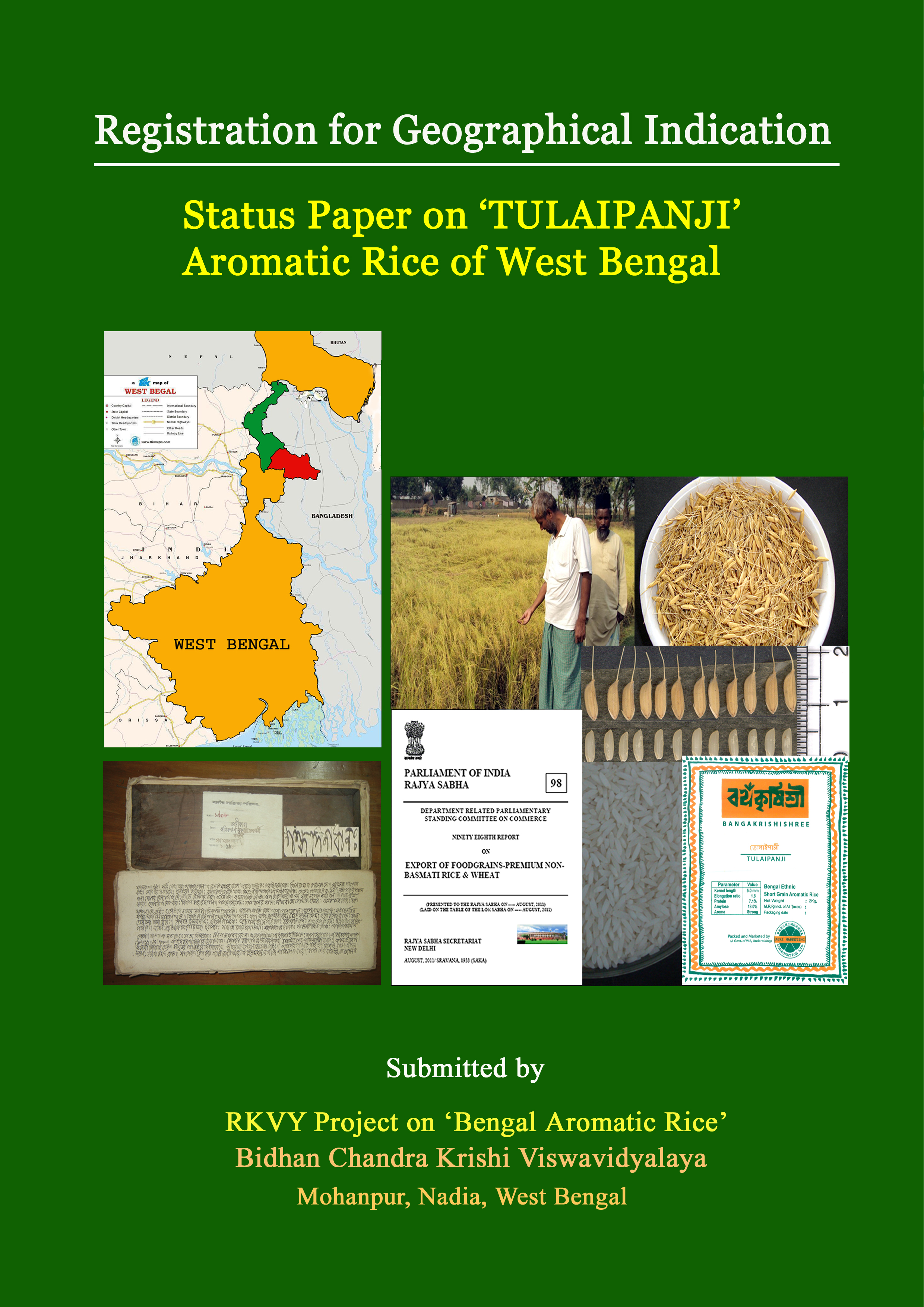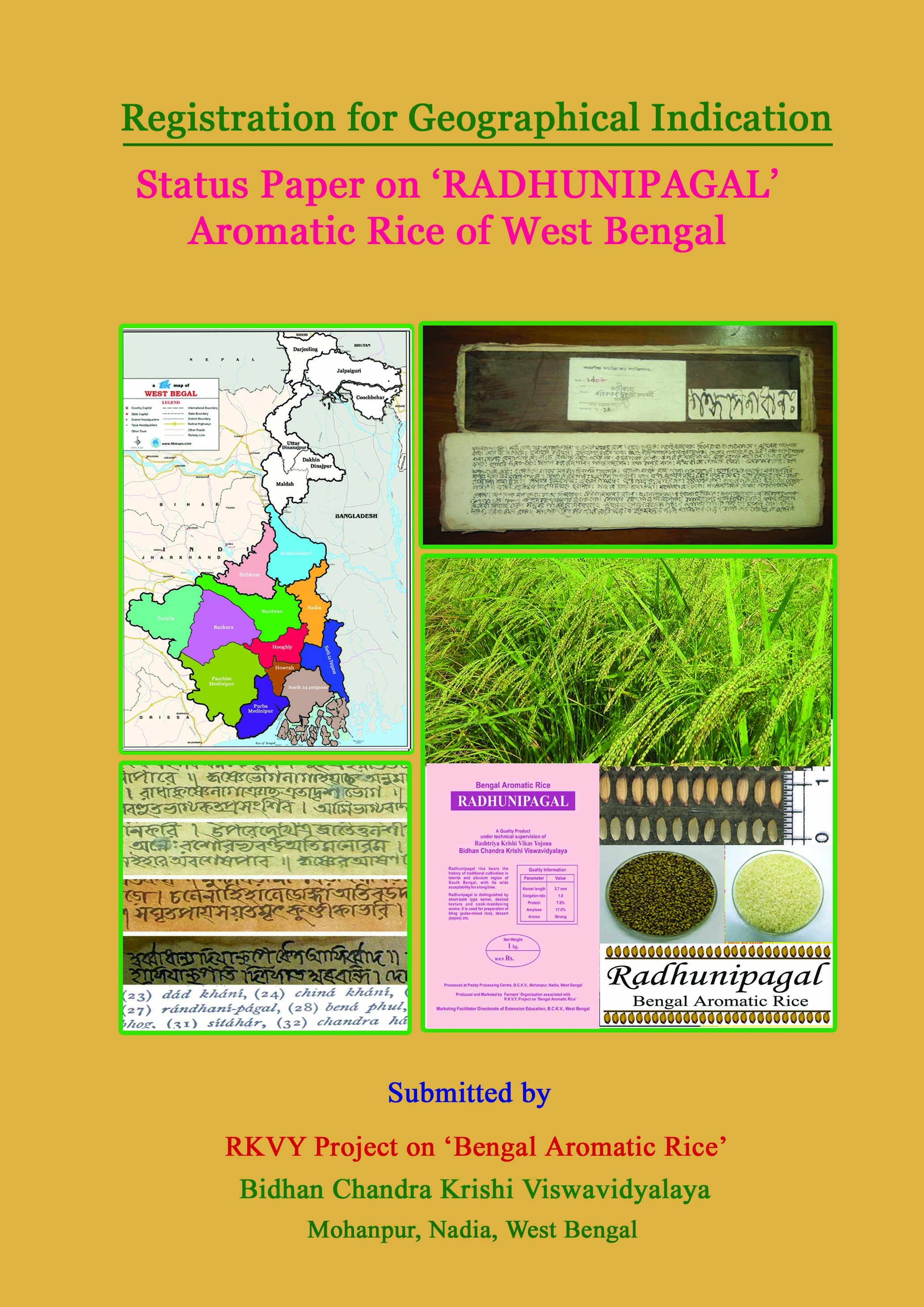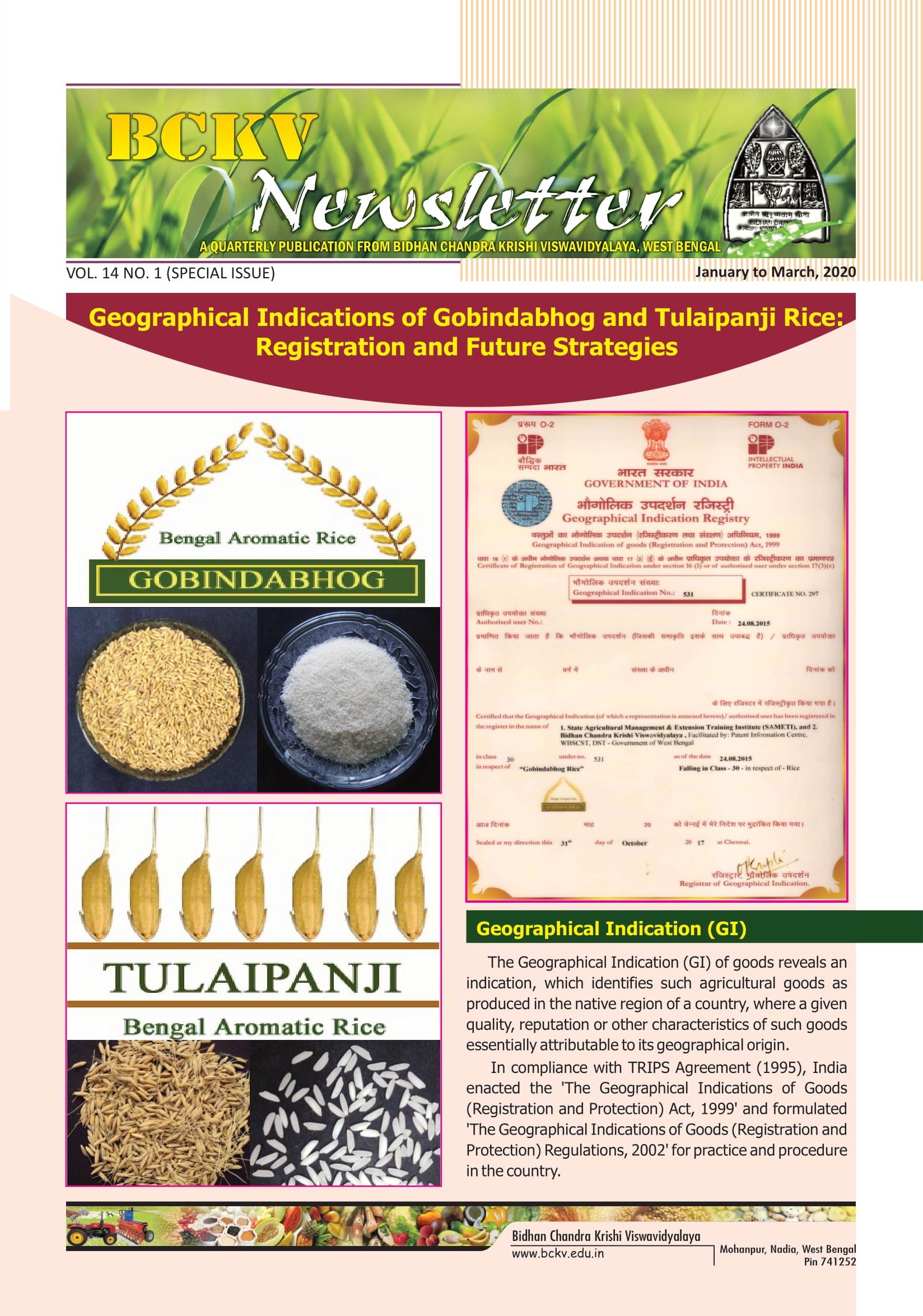GI & AGMARK
Geographical Indication (G.I.)
The Geographical Indication (GI) of goods reveals an indication, which identifies such agricultural goods as produced in the native region of a country, where a given quality, reputation or other characteristics of such goods essentially attributable to its geographical origin.
The RKVY Project Team on ‘Bengal Aromatic Rice’ of BCKV in collaboration with UBKV prepared four Status Papers on four premium aromatic rices (Gobindabhog, Tulaipanji, Kalonunia and Radhunipagal), based on the history, traditional cultivation, grain quality, market potentiality, etc., which were recommended by the Vice Chancellor of BCKV and subsequently submitted to the Patent Information Centre, West Bengal State Council of Science and Technology, Department of Science and Technology, Government of West Bengal during 2014. BCKV designed the GI logos of all four varieties considering the shape, colour and characteristics of grain along with ‘Bengal Aromatic Rice’ brand to protect the premium wealth with market-promotional activities in future.
| Status Paper | Submitted to | Time of Submission |
|---|---|---|
| Status Paper on 'Tulaipanji rice' | Patent Information Centre, Govt. of West Bengal | July, 2014 |
| Status Paper on 'Gobindabhog rice' | Patent Information Centre, Govt. of West Bengal | August, 2014 |
| Status Paper on 'Kalonunia rice' | Patent Information Centre, Govt. of West Bengal | February, 2016 |
| Status Paper on 'Radhunipagal rice' | Patent Information Centre, Govt. of West Bengal | May, 2016 |
The technical and legal documents on Gobindabhog and Tulaipanji rice prepared by the Patent Information Centre based on the Status Papers and Logo provided by the RKVY Project on ‘Bengal Aromatic Rice’ (BCKV and UBKV), and information and documents supplied by Rice Research Station (Department of Agriculture, Government of West Bengal), were separately submitted to the GI Registry, Intellectual Property Office, Government of India during July, 2015.
As per discussion in the Consultative Group Meeting for Gobindabhog and Tulaipanji rice held at BouddhikSampadBhavan, Salt Lake, Kolkata on 22 August, 2016 followed by a state-level meeting at VigyanChetanaBhavan, Salt Lake, Kolkata on 24 October, 2016, Bidhan Chandra KrishiViswavidyalaya (BCKV) and State Agri. Management and Extension Training Institute (SAMETI), Government of West Bengal applied jointly for filing the application for GI of Gobindabhog rice. Likewise, Uttar BangaKrishiViswavidyalaya (UBKV) and State Agri. Management and Extension Training Institute (SAMETI) became applicant for GI of Tulaipanji rice and Patent Information Centre, would be facilitator for both the premiumrices. Finally, both Gobindabhog and Tulaipanji have been registered as premium traditional aromatic rices of West Bengal under GIduring October, 2017.
In the same way, the techno-legal documents of Kalonunia and Radhunipagalrice were prepared based on the Status Papers and Logo provided by the RKVY Project on ‘Bengal Aromatic Rice’ (BCKV and UBKV), and information and documents supplied by Rice Research Station, Department of Agriculture, Hooghly, those were also submitted to GI Registry during 2018. Kalonunia has been registered during December, 2023 and Radhunipagal is in the process of GI registration under Government of India.
| Variety | Crop | Geographical Area / District | Applicant / Owner | Present Status |
|---|---|---|---|---|
| Gobindabhog | Aromatic Rice | Burdwan, Bankura, Hooghly, Nadia, Murshidabad, Birbhum, Howrah, North 24 Parganas | July, 2014 |
Registered (GI No. 531/2017) |
| Tulaipanji' | Aromatic Rice | Uttar Dinajpur, DakshinDinajpur and parts of Darjeeling | August, 2014 |
Registered (GI No. 530/2017) |
| Kalonunia | Aromatic Rice |
Jalpaiguri, Coochbehar, Alipurduar, parts of Darjeeling and Uttar Dinajpur |
February, 2016 |
Registered (GI No. 743/2023) |
| Radhunipagal | Aromatic Rice | Birbhum, Bankura, Purulia, Nadia, Howrah, Hooghly, Medinipur, North 24 Pargans | May, 2016 |
Pre Examination (Application No. 1042/2015) |
AGMARK and New Category of ‘Non-Basmati Aromatic Rice’
AGMARK is a certification mark for agricultural produce, assuring that they conform to a grade standard notified by Directorate of Marketing & Inspection (DMI), Department of Agriculture, Cooperation and Farmers Welfare, Ministry of Agriculture & Farmers Welfare under Agricultural Produce (Grading Marking) Act, 1937.
With the initiative from the Assistant Agricultural Marketing Advisor, Directorate of Marketing and Inspection, Government of India, the RKVY Project on ‘Bengal Aromatic Rice’ prepared one Proposal for inclusion of two aromatic rice of West Bengal (Gobindahog and Tulaipanji) and another proposal for inclusion of four aromatic rice varieties of West Bengal (Radhunipagal, Kalonunia, Kataribhog and Badshabhog) as commercial varieties in ‘Rice Grading and Marketing Rules’ under AGMARK, which duly recommended by the Vice Chancellor of BCKV was submitted to the Head Office, Directorate of Agricultural Marketing and Inspection, Government of India, Faridabad, Hariana during June, 2015 and September, 2016, respectively.
There are much variations in methods of classification of rice varieties as defined by different Departments / Directorates under Government of India for trading of rice in open market and public distribution system in the country as well as export in foreign countries. With a view to promote the small and medium grain non-Basmati type aromatic rice varieties grown in different parts of the country the RKVY Project team on ‘Bengal Aromatic Rice’ submitted a proposal for a new category ‘Non-Basmati Aromatic Rice’ with difference from long-grain Basmati and other common varieties to the Directorate of Agricultural Marketing and Inspection, Government of India, Faridabad, Haryana during August, 2016.
| Proposal | Purpose | Submitted to | Date of Submission |
|---|---|---|---|
| Proposal for Gobindabhog and Tulaipanji rice | AGMARK | Directorate of Marketing and Inspection, Dept. of Agriculture and Co-operation, Govt. of India | July, 2015 |
| Proposal for Radhunipagal, Kalonunia, Kataribhog and Badshabhog rice | AGMARK | Directorate of Marketing and Inspection, Dept. of Agriculture and Co-operation, Govt. of India | February, 2016 |
| Proposal for Classification and Grading of Rice Varieties | AGMARK | Directorate of Marketing and Inspection, Dept. of Agriculture and Co-operation, Govt. of India | August, 2016 |
| Proposal for Radhatilak and Kalojira rice | AGMARK | Directorate of Marketing and Inspection, Dept. of Agriculture and Co-operation, Govt. of India | May, 2023 |
| Proposal for Harinakhuri and Lal Badshabhog rice | AGMARK | Directorate of Marketing and Inspection, Dept. of Agriculture and Co-operation, Govt. of India | June, 2023 |
As per communication from the Directorate of Agricultural Marketing and Inspection, Government of India, Faridabad, Haryana, the RKVY Project on ‘Bengal Aromatic Rice’ of BCKV and UBKV sent a total 116 samples of Gobindabhog and 76 samples of Tulaipanji rice collected from different farmers’ organizations of native districts during September, 2015 – January, 2016, and 84 samples of Radhunipagal, 80 samples of Kalonunia, 80 samples of Kataribhog and 17 samples of Badshabhog rice collected from farmers’ groups from native districts during February, 2018 – February, 2021 to the Eastern Region office at Kolkata for testing of grain quality at Central AGMARK Testing Laboratory, Nagpur.
Based on the quality test reports, a meeting was held on 05.07.2023 for finalization of grade specifications of above-mentioned 5 scented rice varieties of West Bengal, where both BCKV and UBKV put meaningful contribution for the purpose. As a result, the draft Gazette Notification entitled, ‘Non-Basmati Aromatic Rice Grading and Marking Rules, 2023’ including 5 aromatic rice varieties (Gobindabhog, Tulaipanji, Kataribhog, Kalonunia and Radhunipagal) has been published on 16.10.2023. So, the registration of above-mentioned 5 scented rice varieties for AGMARK will be completed within a short period.




